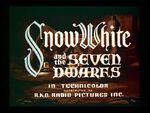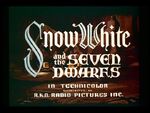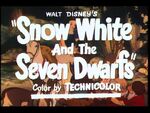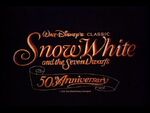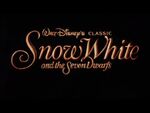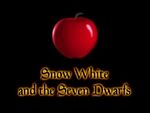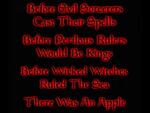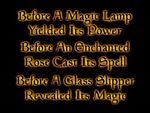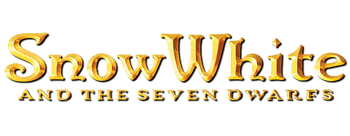- “His first full-length feature production.”
- ―Tagline
Snow White and the Seven Dwarfs is a 1937 musical comedy fantasy animated film. It is America's and, also, one of the world's first feature-length animated films, as well as the first feature film to be animated using traditional animation. It is also the first one in the world to be translated in English; and the first movie to be photographed in Technicolor. It is produced by Walt Disney Productions, premiering on December 21, 1937; it was originally released to theaters by RKO Radio Pictures on February 4, 1938. The film was adapted from the fairy tale by the Brothers Grimm, in which an evil queen attempts to have her stepdaughter, Snow White, murdered in jealousy of her beauty. But she manages to escape, and is given shelter by seven dwarfs at their cottage in the forest.
The film is generally considered to be Walt Disney's most significant achievement, his first-ever animated feature. It was also the first major one made in the United States, the most successful one released in 1938, and, when adjusted for inflation, became the tenth highest-grossing feature film of all time. This historical moment in the art of animation changed the course of motion picture history. Before 1937, short subject cartoons took up the majority of American animation.
The film was adapted to the screen by Dorothy Ann Blank, Richard Creedon, Merrill De Maris, Otto Englander, Earl Hurd, Dick Rickard, Ted Sears, and Webb Smith and was supervised by David Hand, and directed by William Cottrell, Wilfred Jackson, Larry Morey, Perce Pearce, and Ben Sharpsteen. It's particularly memorable for songs, such as "Whistle While You Work", "Heigh-Ho", and "Someday My Prince Will Come"; several frightening and intense sequences; and an artistic style influenced by European storybook illustrations.
A live action remake will be in theaters, March 21, 2025.
Plot[]
Snow White is an orphaned young princess living with her stepmother, the Queen, who cares only about being "the fairest one of all". Fearing that Snow White's beauty will one day overshadow her own, the Queen dresses her in rags and forces her to work as a scullery maid in her castle. Each day, she also consults her magic mirror, and as long as it says that she is the fairest of all, the Queen is content, until one morning the mirror says that Snow White is now fairer than her. That same day, while working in the courtyard, Snow White sings and attracts the attention of a prince riding nearby. Startled by his presence, Snow White runs indoors, but goes out onto the balcony when the Prince serenades her, and they fall in love with each other. Unbeknownst to them, the scene is being observed by the Queen, who grows more jealous of Snow White's beauty.
The Queen summons the Huntsman, ordering him to take Snow White far into the forest and kill her; she also demands to bring back Snow White's heart in a jeweled box as proof. The Huntsman reluctantly takes Snow White to a secluded glade, where she helps a baby bird find its parents. The Huntsman realizes that he cannot bring himself to kill Snow White and warns her of the Queen's intentions, pleading for her to hide in the woods and never come back. Frightened, Snow White flees through the forest (with her fear manifesting itself in what she sees around her) until she falls to the ground and breaks down sobbing. She is comforted and befriended by the woodland animals, whom she asks if they know a place where she could stay.
The animals lead Snow White to the cottage of the seven dwarfs (Doc, Grumpy, Happy, Bashful, Sneezy, Sleepy, and Dopey) deep in the forest, which she finds empty and dirty. Snow White assumes that seven orphaned children live there, and proceeds to clean the place with the animals' help, hoping that this may persuade the owners to let her stay. After cleaning the cottage, Snow White finds the bedroom and falls asleep. Meanwhile, the dwarfs work in a nearby mine digging for diamonds, until it is time for them to go home. When the dwarfs return, they are alarmed to find that the cottage is clean, and suspect that it has been invaded. The dwarfs discover Snow White when she wakes up and introduces herself. She offers to clean and cook for them, and the dwarfs allow her to stay (although Grumpy is reluctant). As Snow White cooks the dinner, she orders the dwarfs to wash in a trough outside the cottage.
After dinner, the dwarfs throw a party for Snow White, entertaining her with music and dancing. After she tells them about the Prince she has fallen in love with, Snow White sends the dwarfs up to bed, but they decide to stay downstairs, allowing her to sleep in their beds. Meanwhile, the Queen once again consults the magic mirror, who tells her that Snow White is not dead, but lives in the dwarfs' cottage. Realizing that the Huntsman has tricked her, the Queen decides to dispose of Snow White herself. The Queen descends into her laboratory in the castle's dungeon, where she prepares a potion to disguise herself as a hag-like peddler and a poisoned apple to put Snow White into a death-like sleep. The Queen learns that a victim of the curse can be revived by "love's first kiss," but she is sure that Snow White will be buried alive before this happens. The Queen leaves the castle by boat and heads to the dwarfs' cottage.
The next morning, the dwarfs go to work in the mine, warning Snow White before leaving not to let any strangers into the cottage. As Snow White makes pies for the dwarfs, the Queen comes to the cottage and offers her the poisoned apple. Noticing a pair of vultures, the animals sense danger and attack the Queen, but Snow White takes pity on her and lets her into the cottage. The animals rush to the mine to warn the dwarfs, who (realizing that Snow White is in danger) hurry back home with them. Meanwhile, the Queen persuades Snow White to take a bite of the apple, and the latter falls into a death-like sleep. As the Queen leaves the cottage, the dwarfs arrive and chase her up a rocky hill, eventually cornering her on a cliff. The Queen tries to crush the dwarfs with a boulder, but before she can do so, lightning strikes the cliff, causing her to fall and get crushed to death by the boulder (with the vultures flying down to devour her remains).
The dwarfs mourn a seemingly dead Snow White, but they are unwilling to bury her in the ground, and instead place her into a glass coffin in a peaceful glade and stand watch. The following spring, the Prince (who has been searching for Snow White) arrives to the coffin and kisses her, which breaks the spell, much to everyone's joy. Awakened, Snow White bids farewell to the dwarfs and animals and rides off with the Prince to his castle to live happily ever after.
Cast[]
- Adriana Caselotti as Snow White
- Lucille La Verne as the Evil Queen
- Roy Atwell as Doc
- Pinto Colvig as Grumpy, Sleepy, Dopey (hiccups)
- Otis Harlan as Happy
- Scotty Mattraw as Bashful
- Billy Gilbert as Sneezy
- Eddie Collins as Dopey
- Harry Stockwell as the Prince
- Stuart Buchanan as the Huntsman
- Moroni Olsen as Magic Mirror
- Marion Darlington and Purv Pullen as Birds
- Clarence Nash as Birds and Animals
Non-speaking roles are the forest animals, the raven, and the vultures.
Jimmy MacDonald provided additional voiceover work, including the yodeling, heard in "The Silly Song".
Production[]
- “I don't know why I picked Snow White. It's a thing I remembered as a kid. I saw Marguerite Clark in it in Kansas City one time when I was a newsboy. They had a big showing for all the newsboys. And I went and saw Snow White. It was probably one of my first big feature pictures I'd ever seen. That was back in 1916 or something. Somewhere way back. But anyways, to me I thought it was a perfect story. I had the sympathetic dwarfs and things. I had the prince and the girl. The romance. I had the heavy. I just thought it was a perfect story.”
- ―Walt Disney[1]
Walt Disney had been contemplating making his first feature film since 1933, when his studio focused on producing animated short films (such as the innovative Silly Symphony series).[2][3] Despite the success with the audience, Disney felt that the short subjects could not provide the studio with a significant profit and advance its further growth.[1][3] He was also interested in expanding his "storytelling possibilities" through a full-length format that would allow for more elaborate and leisurely character development.[3][4] It is thought that Disney's idea was influenced by his favorite comic actors (Laurel & Hardy and Charlie Chaplin), who had already moved from shorts to features for similar reasons.[5] Cartoonist James Thurber recommended that Disney consider Homer's poems Iliad or Odyssey, and Douglas Fairbanks discussed with Disney the possibility of the film adaptation of Jonathan Swift's book Gulliver's Travels.[6] In the spring of 1933, Disney was in talks with producer Merian C. Cooper about doing a full-length animated version of Victor Herbert's operetta Babes in Toyland in Technicolor; the project was offered to RKO Radio Pictures (which owned the rights to the play), but was turned down.[7][8] By April 1933, Disney planned to make an animated/live-action adaptation of Lewis Carroll's novel Alice in Wonderland (with Mary Pickford attached to the title role), but it was scrapped when Paramount announced its own all-star version.[3][6] Disney then considered a film adaptation of Washington Irving's short story Rip Van Winkle starring Will Rogers, but it was also abandoned when Paramount (which owned the rights to the story) refused to grant permission.[9][10]

Walt Disney posing with portraits of the film's characters, c. 1937.
After the successful release of Three Little Pigs in May 1933, Disney was strengthened in his resolve to make a feature film.[1][8] At the same time, the Brothers Grimm's fairy tale Snow White was discussed as a potential Silly Symphony, but the studio chose not to proceed with it.[8] By July 1933, Disney first publicly spoke of his intention to produce a feature in an interview with The Film Daily and began introducing the idea to his staff through slow infiltration (dropping it on everyone individually in the midst of casual conversations).[2] Around the same time, Disney was approached by director Sidney Franklin with a proposal for an animated version of Felix Salten's novel Bambi, a Life in the Woods, but Disney felt that Bambi posed too many technical challenges for his studio at the time, and declined the offer by October 1933.[2][6] In the spring of 1934, Disney finally decided on Snow White, believing that it had enough potential for a feature film adaptation.[3][7] Disney had been familiar with the story since he was a teenager, having seen a silent film version starring Marguerite Clark in a free showing in Kansas City in January 1917.[11][12] He later said that this film played a big part in selecting Snow White for his first feature production (it is unknown whether the film was available for reference during the production of Disney's version).[5][12]
On June 3, 1934, The New York Times reported that Disney "contemplates spending $250,000 on a full-length feature based upon Snow White and the Seven Dwarfs; if, after it is made, he thinks it will disappoint the public, he will destroy it."[13] The project (then referred to as the "Feature Symphony") was initially developed by a small group of writers under Disney's direct supervision, but once the basic storyline was set up, Disney unveiled his plans to the entire staff on October 30, 1934.[1][4][14] Ken Anderson recalled that Disney gave each of his key animators fifty cents, took them out to dinner, after which he took them to the studio's sound stage, where he told them the entire story of Snow White, acting out every part.[3] Although they were impressed by the idea, the animators were unsure that a full-length animated film would sustain the audience's full attention.[5][15] Disney's wife Lillian and his brother Roy (who was also his business partner) attempted to discourage him from continuing the film, while movie industry insiders dubbed the project "Disney's Folly", predicting that it would fail.[16][17] Ward Kimball said that they were told by Hollywood moguls (such as W. C. Fields) that "it was OK, six-seven minutes, like the shorts, but an hour and a half, no way! Big reason was that you run out of funny things to do, so you had to have a laugh-a-minute. And the bright colors would hurt your eyes, everybody would get up and walk out… Walt, of course, plugged ahead, he didn't believe that. He felt that if you had a solid story, not only laughs in it, but pathos, tragedy, it would go."[5][18]
Story development[]
Early ideas[]
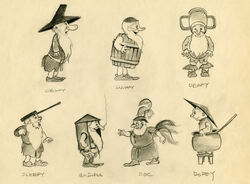
A wide range of names and design possibilities was suggested for the dwarfs during the film's preproduction.[19]
The earliest known story document titled "Manuscript" (also known as "Snowwhite Suggestions") was assembled by staff writer Richard Creedon at Walt Disney's request on August 9, 1934, featuring twenty-one pages of suggestions for characters, scenes, and songs (including Someday My Prince Will Come).[2][13] This exploratory outline closely followed the plot of the Grimms' tale, but with various embellishments, due to Disney and his writers adopting a wide-ranging approach at the time (remaining open to any idea that might be suggested).[20] For instance, the "Manuscript" included an elaborate sequence of Snow White passing through a series of enchanted places (Upsidedownland, Boogeyland, the Sleepy Valley, the Morass of Monsters, and the Valley of the Dragons) before the forest animals lead her to the cottage of the seven dwarfs.[7][21] Another suggested scene involved the Queen imprisoning the Prince in a dungeon after seeing his ardor for Snow White, with the Prince later leaping his way through the castle guards "with tricks that Doug Fairbanks would like to have thought of."[22][23] Among the minor suggestions for the "Manuscript" were an almost tomboyish Snow White "singing a happy hunting song and putting her horse over walls and water jumps" on her ride into the forest with the Huntsman; the Queen keeping a collection of her former enemies reduced to miniature size; and a couple of scenes featuring the Queen and her minions (a Gilbert and Sullivan-esque musical number of the Queen bartering with the Huntsman to kill Snow White; and the sequence of the Magic Mirror stalking the Queen about the room before smashing itself upon her).[24][25][26][27] From the start, Disney intended to distinguish the seven dwarfs (whose names were not stated in the original story) from one another through names and corresponding characteristics, considering them to be the story's "strongest lure" due to their comedic potential.[28] A pool of about fifty potentials was compiled for the "Manuscript", which included such names as Awful, Hoppy, Weepy, Dirty, Cranky, Hungry, Sneezy-Wheezy, Lazy, Snoopy, Goopy, Wistful, Soulful, Gabby, Blabby, Flabby, Crabby, Helpful, Tearful, Thrifty, Shifty, Nifty, and Biggo-Ego.[19][29]
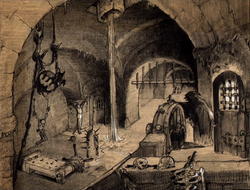
The sequence of the Queen imprisoning the Prince in her dungeon remained in the story as late as October 1936.[22]
By October 1934, Disney began to hold weekly story meetings with a small group of writers, which included Creedon, Larry Morey, Ted Sears, Albert Hurter, and Pinto Colvig.[20][28] At this stage, Disney envisioned the picture as a kind of "animated Marx Brothers comedy," with realistic leads providing a frame for comical characters.[30] At the first meeting on October 3, several new scenes were proposed, such as the "Soup Eating" and "Bed Building" sequences; Snow White teaching the dwarfs to say prayers; and the final chase, with the Queen's death by falling from the rocks.[31] For the next meeting on October 9, a typed sheet with a redefined list of the dwarfs' names (Wheezy, Jumpy, Baldy, Grumpy, Happy, Doc, and Sleepy) was distributed; other names mooted included Hickey, Gabby, Nifty, Sniffy, Lazy, Puffy, Stuffy, Shorty, Wheezy, Burpy, Dizzy, and Dopey.[31][32] From the outset, Disney abandoned the Queen's attempt to kill Snow White with a tightly-laced bodice from the Grimms' tale, but considered retaining the other two with a poisoned comb and a poisoned apple (both of which were outlined at the meeting).[21][22][31] Other discussions involved the dwarfs' discovery of Snow White in their cottage; two disguises for the Queen's attempts to kill Snow White (a "fat, bulgy peddler type" and a "thin, hawk-faced, old witch"); and Snow White kissing the dwarfs before sending them off to work.[31][32][33] At the meetings held on October 13 and October 15, two different versions of the Queen's appearance (a "fat, vain, batty, self-saturated cartoon type" and a "high-collar, stately beauty") and a scene of a musical interlude at the dwarfs' cottage were suggested.[31][34][35] During the last three meetings, the sequence of the Prince's imprisonment by the Queen was also elaborated: after failing to kill Snow White with the comb, the Queen throws the Prince into the dungeon, and uses magic to make the skeletons of her earlier victims perform a gruesome dance for him (identifying one skeleton as "Prince Oswald").[31][32] Before leaving to kill Snow White with the poisoned apple, the Queen floods the dungeon to drown the Prince, but the castle's birds liberate him, after which he fights the guards.[22][32] Then the prince escapes from the castle on his horse and pursues the Queen, but takes the wrong road in the process.[31][32]

Early story sketches depicted Snow White as a blonde, despite the original story's reference to "hair black as a ebony."[36]
After the meeting on October 15, Creedon prepared an eighteen-page tentative outline containing story suggestions from previous meetings; around fifty copies of the document circulated in the studio on October 22.[28] The outline also included a complete breakdown of the characters' cast and indicated that Disney wanted to "start an actual work at the point where Snow White finds the cottage of the Seven Dwarfs".[28][32][37] The dwarfs were now listed as Happy, Sleepy, Doc, Bashful, Grumpy, Jumpy, and an unnamed seventh dwarf.[28][38] On November 2 (after revealing the project to the rest of the studio staff), Disney issued a circular offering bonuses of five dollars for every gag submitted for Snow White; one such gag (suggested by Ward Kimball) included the dwarfs' noses popping over the foot of the bed when they discover Snow White.[3][38][39] However, Walt was concerned that such a comical approach would lessen the plausibility of the characters and, sensing that more time was needed for the development of the Queen, advised in an outline circulated on November 6 that attention be paid exclusively to "scenes in which only Snow White, the Dwarfs, and their bird and animal friends appear." The names and personalities of the dwarfs, however, were still "open to change." A meeting of November 16 resulted in another outline entitled "Dwarfs Discover Snow White", which introduced the character of Dopey, who would ultimately prove to be the most successful and popular of the dwarfs. For the rest of 1934, Walt further developed the story by himself, finding a dilemma in the characterization of the Queen, who he felt could no longer be "fat" and "batty", but a "stately beautiful type" (a possibility already brought up in previous story meetings).
Reworking[]
Walt Disney did not focus on the project again until fall 1935; it is thought that he may have doubted his studios' ability and that his trip to Europe that summer had restored his confidence. At this point, he and his writers focused on the scenes in which Snow White and the dwarfs are introduced to the audience and each other. He laid out the likely assignments for everyone working on the film in a memorandum of November 25, 1935, and had decided on the personalities of the individual dwarfs.
Though it had first been thought that the dwarfs would be the main focus of the story, and many sequences were written for the seven characters; at a certain point, it was decided that the main thrust of the story should be provided by the relationship between the Queen and Snow White. For this reason, several sequences featuring the dwarfs were cut from the film. The first, which was animated in its entirety before being cut, showed Doc and Grumpy arguing about whether Snow White should stay with them. Another, also completely animated, would have shown the dwarfs eating soup noisily and messily; Snow White (unsuccessfully) attempts to teach them how to eat 'like gentlemen'. A partially animated sequence involved the dwarfs holding a 'lodge meeting' in which they try to think of a gift for Snow White; this was to be followed by the elaborate 'bed building sequence', in which the dwarfs and the forest animals construct and carve a bed for Snow White, but was cut, as it was thought to slow down the movement of the story. The soup-eating and bed-building sequences were animated by Ward Kimball, who was sufficiently discouraged by their removal to consider leaving the studio, though he ultimately decided to remain.
Art direction[]
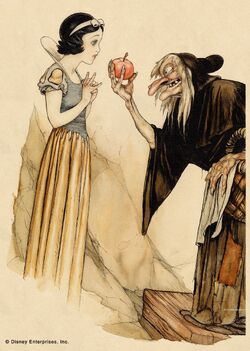
Artists, such as Gustaf Tenggren introduced the influence of European illustrators.
During his trip to Europe in the summer of 1935, Walt Disney acquired nearly three hundred and fifty books, featuring the illustrations of artists such as Arthur Rackham, Gustave Dore, Honore Daumier, Grandville, Benjamin Rabier, Ludwig Richter, Wilhelm Busch, Heinrich Kley, Attilio Mussino, Sir John Tenniel, and Charles Folkard (many of these illustrators had been recommended by Hurter and Joe Grant). He added all these books to the studio library, and a further 90 from France, 81 from England, 149 from Germany, and 15 from Italy, were added to the library in July of the same year. The Disney artists and animators frequently borrowed and referred to the books of the studio library, which could frequently be seen on drawing boards. Rackham's influence on the style of the film is perhaps the most obvious; his illustrations of gnarled trees coming to life inspired the faces Snow White sees in her flight through the forest, his depictions of dwarfs, gnomes, and goblins played a part in the design of the seven dwarfs, and similarities have been noted between Joe Grant's design for the Witch and the old woman in Rackham's illustration for "Hansel and Gretel". However, the other illustrations influenced various different elements of the film. Dore's etchings for Dante's Divine Comedy, in particular, inspired the caverns below the Queen's castle, as did Piranesi's "Carceri" series. It is rumored that Disney intended to recruit Rackham for the visual development of Snow White and the Seven Dwarfs, but that the illustrator was too frail to move to America.
The primary authority on the film's design was inspirational sketch artist Albert Hurter; all the designs (from characters and costumes to settings and scenery) had to receive his approval before being finalized. Two other inspirational sketch artists contributed to the visual style of the film: Ferdinand Horvath (whose designs were often thought not to be as easily translated into animation as Hurter's, but who produced a number of dark concepts for the film) and Gustaf Tenggren, whose style borrowed from the likes of Arthur Rackham and John Bauer and thus possessed the European illustration quality that Walt was interested in. Tenggren was used primarily as a color stylist and to determine the staging and atmosphere of many of the scenes in the film. He also designed the poster for it and illustrated the press book. However, only Hurter receives a credit for it, as a character designer. Other artists to work on the film included Joe Grant, whose most significant contribution was the design for the Queen's witch form.
Character design and animation[]

An early sheet of suggested models for Snow White, the Queen, and the Prince by Albert Hurter.[13]
Art Babbit, an animator who joined the Disney studio in 1932 invited seven of his colleagues (who all worked in the same room as him) to an art class that he himself had set up at his home in the Hollywood Hills. Though there was no teacher, he had recruited a model to pose for him and his fellow animators as they drew. These 'classes' were held weekly; each week, more animators would come. After three weeks, Walt called him to his office and offered to provide the supplies, working space, and models required if the sessions were moved to the studio. He ran the sessions for a month until animator Hardie Gramatky suggested that they recruit Don Graham the art teacher from the Chouinard Institute taught his first class at the studio on November 15, 1932, and was joined by Phil Dike a few weeks later. These classes were principally concerned with human anatomy and movement, though instruction later included action analysis, animal anatomy, and acting. Though the classes were originally described as a "brutal battle", with neither instructor nor students well learned in the other's craft, the enthusiasm, and energy of both parties made the classes stimulating and beneficial for all involved. Graham would often screen Disney shorts and, along with the animators, pick out both strengths and weaknesses. For example, Graham criticized Babbit's animation of Abner Countrymouse in The Country Cousin as "taking a few of the obvious actions of a drunk without coordinating the rest of the body", while praising it for maintaining its humor without getting "dirty or mean or vulgar. The country mouse is always having a good time."
Very few of the animators at the Disney studio had had artistic training (most had been newspaper cartoonists); among these few was Grim Natwick who had trained in Europe. The animator's success in designing and animating Betty Boop for the Fleischer cartoons showed an understanding of human female anatomy, and when Walt hired Natwick he was given female characters to animate almost exclusively. Attempts to animate Persephone, the female lead of The Goddess of Spring, had proved largely unsuccessful; Natwick's animation of the heroine in Cookie Carnival showed greater promise and was eventually given the task of animating Snow White herself. Though live-action footage of her, the Prince and the Queen was shot as reference for the animators, many of them disapproved of rotoscoping, considering it to hinder the production of effective caricature. None of Babbit's animation of the Queen was rotoscoped; despite Graham and Natwick's objections. However, some scenes of Snow White and the Prince were directly traced from the live-action footage.
Cinematic influences[]
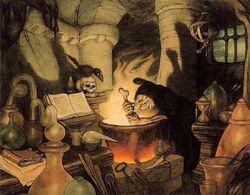
An inspirational sketch by Gustaf Tenggren demonstrates the expressionistic use of shadows in the film.
At this time, Disney also encouraged his staff to see a variety of films. These ranged from the mainstream, such as MGM's Romeo and Juliet (to which Disney made direct reference in a story meeting pertaining to the scene in which Snow White lies in her glass coffin), to the more obscure, including European silent films. The influence of German expressionism (examples of which exist in Nosferatu and The Cabinet of Dr. Calligari both of which were recommended by Disney to his staff) can be found in Snow White (and their future films), particularly in the scenes of Snow White fleeing through the forest and the Queen's transformation into the Witch. The latter was also inspired by 1931's Dr. Jekyll and Mr. Hyde, to which Disney made specific reference in story meetings.
Reception and success[]
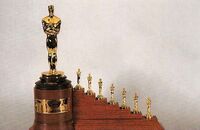
The award presented to Walt Disney. Contains 7 Dwarves with it.
The film premiered at the Carthay Circle Theater on December 21, 1937, to a widely receptive audience (many of whom were the same naysayers that dubbed it "Disney's Folly"), who gave it a standing ovation at its completion. Animator Ward Kimball recalled many people (including many celebrities) crying towards the end. RKO Radio Pictures put it into general release on February 4, 1938, and it went on to become a major box-office success, making more money than any other at that time. It is estimated that more people saw it on its general release than Star Wars. In fact, for a short time, it was the highest-grossing film in American cinema history; it was removed from that spot by Gone With the Wind in 1940.
A subject of particular criticism was the film's depiction of Snow White, the Queen, and the Prince as realistic human figures, which caused some (including successful New York caricaturist Al Hirschfeld) to believe that Walt was too closely following live-action and realism, thus rejecting the qualities that made cartoons, such as the Silly Symphonies unique.
Certain scenes in the film, particularly those featuring the Witch, are regarded as some of Disney's most frightening moments. British censors considered it frightening enough for young viewers to be accompanied by an adult. Animators Frank Thomas and Ollie Johnston felt that Walt restrained his animators from creating such a terrifying villain again. Later films, such as Pinocchio, Fantasia, and Bambi would receive similar accusations for their frightening and intense sequences.
For his achievement in the film, Walt received a full-size Oscar statuette alongside seven miniature ones, presented to him by Shirley Temple; the film was deemed "as a significant screen innovation which has charmed millions and pioneered a great new entertainment field." It was also nominated for Best Music, Score. Review aggregator website Rotten Tomatoes reports that 98% of the critics gave it a positive review based on 52 reviews. Its consensus states, "With its involving story and characters, vibrant art, and memorable songs, Snow White and the Seven Dwarfs set the animation standard for decades to come." The film also gained favorable reviews. It would go on to become the best non-Pixar Disney film ever.
Re-release schedule and home video[]
- Main article: Snow White and the Seven Dwarfs (video)
The film was first re-released in 1944, in order to raise revenue for the Disney studio during World War II. This eventually set a tradition of re-releasing Disney animated films every seven years. It was re-released to theaters in 1952, 1958, 1967, 1975, 1983, 1987, and 1993. It was restored for its 1987 50th-anniversary re-release, and a more comprehensive digital restoration was done for the 1993 re-release.
Being Disney's most signature "untouchable" at the time, the film was never released in its entirety on home video prior to 1994 and therefore was absent from the Walt Disney Classics line of releases. The film was first released on home video on October 28, 1994 as part of the Walt Disney Masterpiece Collection line and was released on Disney DVD in 2001. The DVD was the first in Disney's Platinum Edition line of releases, and featured, across two discs, the digitally restored film, a making-of documentary, an audio commentary by John Canemaker and (via archived audio clips) Walt, and many more special features. The DVD went to the Disney Vault in January 2002.
Walt Disney Studios Home Entertainment has confirmed that the film was released on Blu-ray disc on October 6, 2009, and on a new DVD edition on November 24, 2009, under the Walt Disney Diamond Edition banner. This version had a new restoration by Lowry Digital and had the original 1937 titles restored, including the RKO Radio Pictures logo. The Blu-ray went into the Disney Vault on April 30, 2011.
The film was released on Digital HD on January 19, 2016, and on Blu-ray and DVD on February 2, 2016, as a part of the Walt Disney Signature Collection.
It was reissued on March 22, 2022 from Disney Movie Club as an 85th Anniversary Edition with a special cover and a Blu-ray bonus disc.
Disney released the film on 4K Ultra HD Blu-ray on October 10, 2023.
Videos[]
Gallery[]
Trivia[]
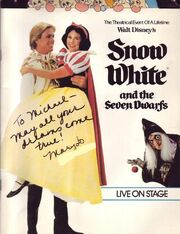
A poster for "Snow White: Live at Radio City Music Hall".
- The film's copyright was renewed on January 22, 1965.[40]
- There have been numerous ideas as to the presence of occult significance or symbolism within the movie, mostly centered around the dwarfs themselves. For example, one theory holds that they correspond to the seven chakras (or cakras) and that Snow White represents consciousness moving through them. Other ideas are less philosophically complex, such as correspondences to the stages inherent in the use of certain drugs. In one theory, Snow White is cocaine, which causes exhaustion (Sleepy), mood swings (Happy, Grumpy), allergies (Sneezy), and alteration of personality (Bashful, Dopey) eventually resulting in a trip to the doctor (Doc). More on this
- The film's title uses the word "dwarfs" which was the traditional plural of "dwarf". The Lord of the Rings by John Ronald Reuel Tolkien, published in three volumes from 29 July, 1954, to 20 October, 1955, instead popularized the spelling "dwarves". Both plural forms have been used interchangeably since then.
- There are only two times the word(s) dwarf(s) has been used. Once by the magic mirror, "Over the seven jeweled hills, beyond the seventh fall, in the cottage of the Seven Dwarfs, dwells Snow White, fairest one of all." And again by the Queen in disguise after finding an antidote for the poisoned apple, "No fear of that! The dwarfs will think she's dead, and they'll bury her alive!"
- Upon seeing the film, Russian director Sergei Eisenstein called it the greatest ever made.
- The song "Someday My Prince Will Come" became a jazz standard and has been performed by numerous artists, including Buddy Rich, Oscar Peterson, and Miles Davis.
- The film was chosen by the American Film Institute as the number one animated film of all time.
- In 1979 the film inspired a stage musical. It premiered at Radio City Music Hall and starred Broadway stage veteran Anne Francine as the Queen and then-unknown Mary Jo Salerno as Snow White. It was directed and staged by Frank Wagner, as well as produced by Robert Jani, and it is known for saving Radio City Music Hall from closing down. In 1980, it was taped and broadcast on HBO as "Snow White Live".
- The film is one of the few Disney classic's to not have a sequel.
- Contrary to what most people think, this is not the first animated film ever. That honor goes to the (now lost) 1917 film El Apóstal whilst the earliest surviving animated film is The Adventures of Prince Achmed, both which were animated using cutout stop-motion.
- The dwarfs have only four fingers; a thumb, and three other digits.
- The film was Disney's first animated feature, as well as the first Disney feature overall, to be preserved in the National Film Registry of the Library of Congress. nine other Disney films would later achieve this honor and be preserved in the following future years: Fantasia in 1990, Pinocchio in 1994, Beauty and the Beast in 2002, Bambi in 2011, The Lion King in 2016, Dumbo in 2017. Cinderella in 2018, Sleeping Beauty in 2019, and The Little Mermaid in 2022.
- The 1993 theatrical and 1994 VHS releases have the 1985 Walt Disney Pictures logo at the beginning and restoration credits and the 1990 Walt Disney Pictures logo at the end.
- The 2001 VHS and DVD releases use the same print as for the 1993 theatrical/VHS releases, but with the restoration credits omitted.
- The Blu-ray release, on the other hand, has the original RKO and the CGI Disney logos instead.
- At the end of the film, Snow White only kisses six dwarfs goodbye before leaving with the Prince; the one she left out was Sleepy.
- In March 2016, Disney announced a new film in development titled, Rose Red; a live-action spin-off film which will be told from the point-of-view of Snow White's sister.
- In 2016 Walt Disney Signature Collection was released, with Snow White and the Seven Dwarfs is the first film in that collection.
- The film is the third Disney animated classic to have the 2006 Walt Disney Pictures logo at the end, on current releases.
- However, the 4K print uses the 2011 variant of said closing logo instead.
- This is the only animated film in the Disney Animated Canon during Walt Disney's lifetime to open with the onscreen credit "A Walt Disney Feature Production" in the opening credits instead of "Walt Disney Presents".
- As revealed on the 2009 Blu-ray release, the film originally had the "A Walt Disney Feature Production" credit mentioned twice in the film's original 1937 release, in both the opening credits and in the ending titles, the latter appearing over the RKO logo in the background. On post-1954 theatrical re-releases by Buena Vista Distribution (which also applies on the 1993 theatrical re-release as seen on the 1994 VHS and the 2001 Platinum Edition DVD), the "A Walt Disney Feature Production" credit is kept only in the opening credits, while the original ending title has been replaced by a generic "THE END - A Walt Disney Production" credit as seen on other Disney films of the 1940s up until The Aristocats in 1970.
- In the 1984 movie Gremlins, the Gremlins are seen watching the film in a movie theater.
- The song "Whistle While You Work" was later heard playing in Splash, Too.
- This is one of the few Disney films to not have explicit sequels or extension media (not counting several Disney comics, 7D, or rides). However, a sequel was planned, and there was a planned prequel game that would have been made by Obsidian Entertainment called Dwarfs that had a dark nature to it (with the tutorial level having the Prince committing matricide due to thinking she was a monster), but the latter entry was canceled at then-recently made CEO Bob Iger's order due to the film being deemed "untouchable".
- The closest it has to a true sequel was the children's book Snow White's Return, where she pays a visit to the old cottage and the Dwarfs have to prepare.
- This is the first Walt Disney Animation Studios film to use the full opening credits.
- The film was Disney's first animated feature, to be featured in the Geography Town Official Library, or officially known as Encyclopedia Library, postered in 2009.
- A play, Little Snow White, exists based on the same source material as this film. In this play, the dwarves' song is "Stump-a-thump, stump-a-thump, Duck your head, do not bump." This short play is reprinted in full in the book "A Child's Guide to Knowledge."
- This is the only Disney Princess film to be released during the presidency of Franklin Delano Roosevelt (1882-1945), the 32nd president of the United States, which began in 1933 until his passing in office in 1945.
- This is also the only Disney Princess film to be released during the time of the Great Depression, which was a severe global economic downturn that lasted from 1929 to 1939.
- This is the first Disney Princess film to have turtles.
- The coal mines in 18th Century Germany were manned by children who were known as "dwarves". These children's growth was stunted because they were underfed, and they often became hunchbacked from working in the mines. It doesn't take much to realize how this relates to Snow White, for the coal mines were in the Seven Hills area, where the cottage of the Seven Dwarfs is supposed to be located.
Error[]
- When a skeleton's arm was on one side of the bar, it was at the other side of the bar.
Allusion[]
- At one point, the dwarfs say "Jiminy Crickets", to express their surprise on seeing their house occupied. Since Pinocchio, the phrase has become more synonymous with a voice of reason or conscience.
In Disney Parks[]
The attraction Snow White's Scary Adventures appears in four of the five Disney resorts around the world. Much of the cast also appear as walk-around characters, including Snow White, the Dwarfs, the Prince, and the Queen. Other appearances in the parks include:
- Snow White's Grotto, a small area near Fantasyland at Disneyland, Hong Kong Disneyland, and Tokyo Disneyland.
- The Candy Cauldron, a candy shop specializing in caramel apples at Downtown Disney themed to the Queen and Witch.
- Storybook Land Canal Boats feature the cottage and mine of the Seven Dwarfs.
- Mickey Mouse Revue, an attraction that formerly appeared at the Magic Kingdom and Tokyo Disneyland, featuring Snow White and the Dwarfs.
- Cinderella Castle Mystery Tour, a former Tokyo Disneyland attraction focusing on the villains that featured the Witch's Laboratory.
- Seven Dwarfs Mine Train, a roller coaster constructed as part of the Fantasyland expansion at the Magic Kingdom, and part of the opening at Shanghai Disneyland.
- Fantasmic! features Snow White and the Prince in its Princess medley, and the Queen serves as the primary antagonist. In its Tokyo DisneySea incarnation, the magic mirror plays a larger role in the show, serving as a means of trapping Mickey and a projection surface for the Disney Villains to appear inside, folding back for the climactic encounter with Dragon Maleficent.
Differences from the source material[]
- Snow White's birth parents appear at the beginning of the original story.
- Snow White is only 7 years old when she is declared "the fairest one of all" and the Queen sends the huntsman to kill her. Being a family film, Disney increased her age to 14 to soften the story.
- In the original story, Snow White was not reduced to servanthood.
- The Queen was actually more malice than in the film. In the original story, after the huntsman brings back the heart, liver, and lungs of a boar, the Queen, thinking they are Snow White's, has them made into a stew which she then eats, delighted in knowing that Snow White had been killed.
- In the film, it was the huntsman who told Snow White to run away upon witnessing her innocence and beauty. In the original story, she pleaded with him not to kill her and promised that she would run away in the forest. Believing that she will die anyway, he lets her go and kills a wild boar instead.
- Snow White did not have any animal friends in the original fairy tale.
- In the original story, the dwarfs were much gruffer to Snow White at first, but they grew to love her over time as they let her into their home. In the film, it was only Grumpy whom is much gruffer to Snow White at first, but he then learns to love her over time, even being the first to lead the rest of the dwarfs to go after the Queen after the latter killed her with the poisoned apple.
- In the original story, it was the dwarfs who made a bargain with Snow White. In the film, it was the other way around.
- In the original story, the prince doesn't meet Snow White until after her sleeping death. In the film, the prince and Snow White first meet much earlier when the latter is still alive, and Snow White falls in love with the Prince before being revived by the prince.
- The Queen does not transform into a peddler woman but merely paints her face.
- In the original story, the Queen tried to kill Snow White three times; first was by lacing her bodice up so tightly that she couldn't breathe. When that fails, she tries to drug her with a poisoned comb. And when that also fails, she finally uses a poisoned apple. In the film however, the Queen tried to kill Snow White with only the poisoned apple.
- In the original story, Snow White sleeps in the glass coffin for many years, growing up into a young woman that whole time. In the film, she does so for about one year.
- In the original fairy tale, Snow White actually wasn't awakened by "love's first kiss". Instead, the prince buys the coffin from the dwarfs, and they help him carry it back to his castle (in some versions, the prince's servants assist in doing so). But one of the dwarves trips, causing the coffin to fall, which dislodged the piece of the apple from Snow White's throat.
- At the very end of the story, the Queen attends Snow White and the prince's wedding and is shocked to see that the bride is Snow White. As punishment for her attempted murders, her feet are forcibly placed into red-hot iron shoes that had been sitting on red-hot coals, and she dances until she falls down dead. In the film, she was defeated much earlier; after the dwarfs chase her up a cliff, she soon falls to her death when a bolt of lightning strikes the ledge.
References[]
|
External links[]
 Snow White and the Seven Dwarfs (1937 film) on Wikipedia
Snow White and the Seven Dwarfs (1937 film) on Wikipedia Snow White and the Seven Dwarfs on Disney.com
Snow White and the Seven Dwarfs on Disney.com- Filmic Light: A Snow White Sanctum
- Snow White on Lux Radio Theater: December 26, 1938. Guest appearance by Walt Disney.
- Snow White on Screen Guild Theater: December 23, 1946
| v - e - d | ||||||||||||||||
|---|---|---|---|---|---|---|---|---|---|---|---|---|---|---|---|---|
|

